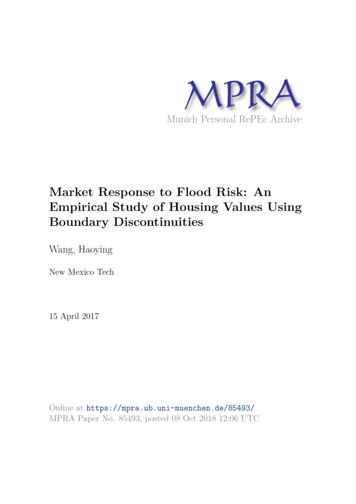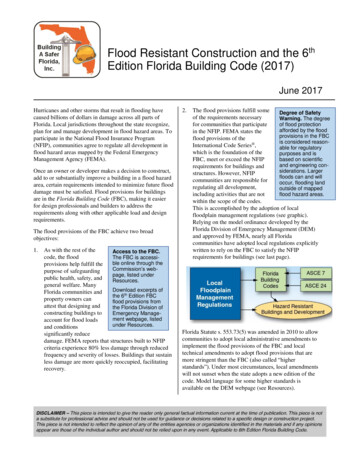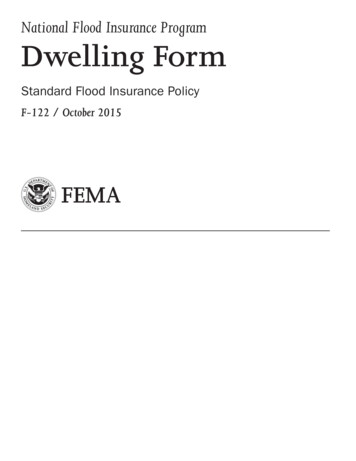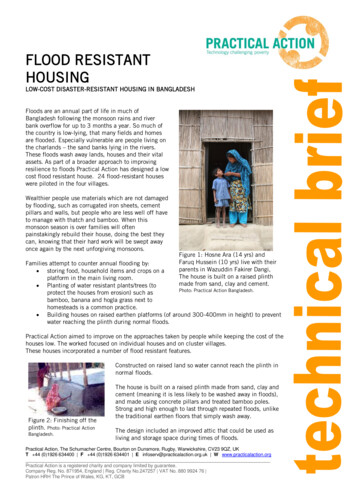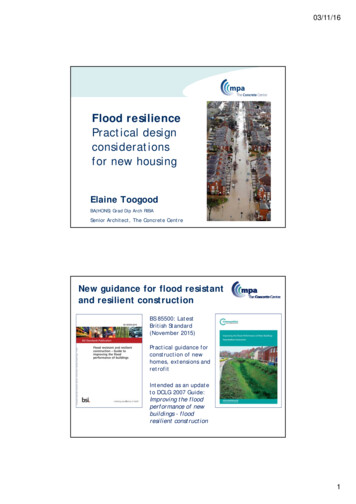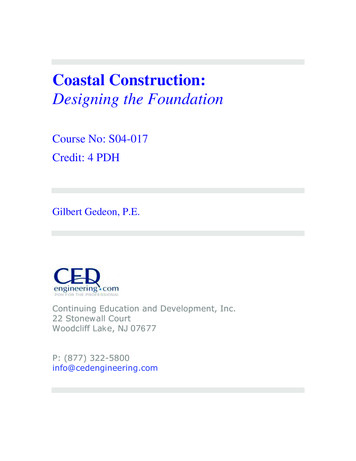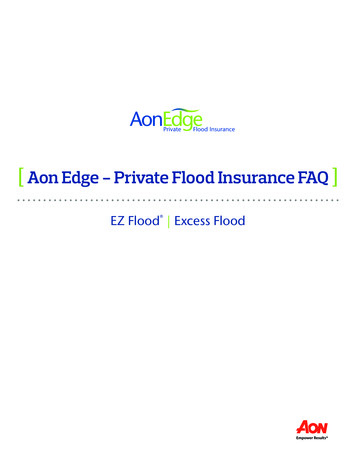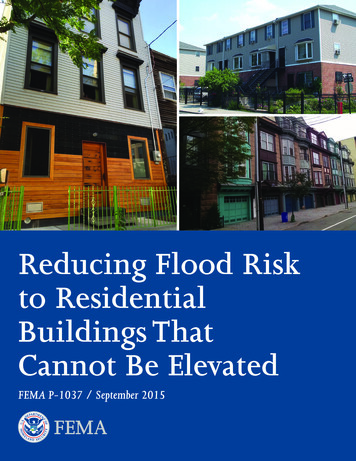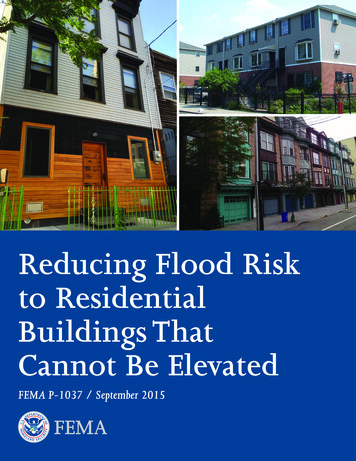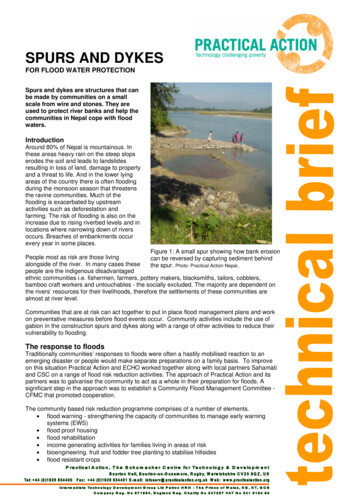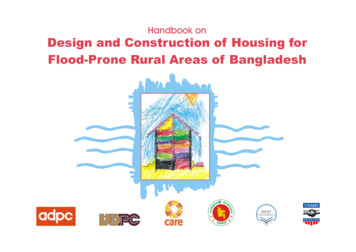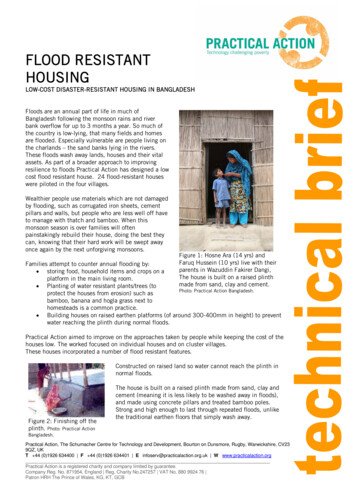
Transcription
FLOOD RESISTANTHOUSINGLOW-COST DISASTER-RESISTANT HOUSING IN BANGLADESHFloods are an annual part of life in much ofBangladesh following the monsoon rains and riverbank overflow for up to 3 months a year. So much ofthe country is low-lying, that many fields and homesare flooded. Especially vulnerable are people living onthe charlands – the sand banks lying in the rivers.These floods wash away lands, houses and their vitalassets. As part of a broader approach to improvingresilience to floods Practical Action has designed a lowcost flood resistant house. 24 flood-resistant houseswere piloted in the four villages.Wealthier people use materials which are not damagedby flooding, such as corrugated iron sheets, cementpillars and walls, but people who are less well off haveto manage with thatch and bamboo. When thismonsoon season is over families will oftenpainstakingly rebuild their house, doing the best theycan, knowing that their hard work will be swept awayonce again by the next unforgiving monsoons.Figure 1: Hosne Ara (14 yrs) andFaruq Hussein (10 yrs) live with theirparents in Wazuddin Fakirer Dangi,The house is built on a raised plinthmade from sand, clay and cement.Families attempt to counter annual flooding by: storing food, household items and crops on aplatform in the main living room. Planting of water resistant plants/trees (toPhoto: Practical Action Bangladesh.protect the houses from erosion) such asbamboo, banana and hogla grass next tohomesteads is a common practice. Building houses on raised earthen platforms (of around 300-400mm in height) to preventwater reaching the plinth during normal floods.Practical Action aimed to improve on the approaches taken by people while keeping the cost of thehouses low. The worked focused on individual houses and on cluster villages.These houses incorporated a number of flood resistant features.Constructed on raised land so water cannot reach the plinth innormal floods.Figure 2: Finishing off theplinth. Photo: Practical ActionThe house is built on a raised plinth made from sand, clay andcement (meaning it is less likely to be washed away in floods),and made using concrete pillars and treated bamboo poles.Strong and high enough to last through repeated floods, unlikethe traditional earthen floors that simply wash away.Bangladesh.Practical Action, The Schumacher Centre for Technology and Development, Bourton on Dunsmore, Rugby, Warwickshire, CV239QZ, UKT 44 (0)1926 634400 F 44 (0)1926 634401 E infoserv@practicalaction.org.uk W www.practicalaction.orgPractical Action is a registered charity and company limited by guarantee.Company Reg. No. 871954, England Reg. Charity No.247257 VAT No. 880 9924 76 Patron HRH The Prince of Wales, KG, KT, GCB
Flood resistant housingPractical ActionThe design included an improved attic that could be used as living and storage space during times offloods.Jute panels make resilient walls that cost very little yet are quick and easy to replace. Treatedbamboo poles on concrete bases are strengthened with metal tie rods to hold the wall firm and safe.Treated jute stick woven mat partitions increase durability.The structure, with woven bamboo walls,can be dismantled in the case of aforecast severe flood, and moved for reerection on a new site or restoration afterfloodwaters subside.Bracings and fastenings bind the wallsfirmly to the house ‘skeleton’ through anetwork of holes and notches – locallycalled a ‘clam system’ – and the wholebuilding can stay standing through thestrongest of winds and rain. Nuts andbolts, screws, ties and nails are required.Figure 3: Julekha Begum is the owner of this housein Yasin Mirdhar Dangi, Faridpur. Photo: Practical ActionBamboo poles are treated to make themmore resilient to flooding so that they lastlonger.Bangladesh.Reinforced concrete posts with footings wereintroduced to strengthen the structure. Shortreinforced concrete stumps for the treated bambooposts make the structure more resilient to the water.Corrugated Galvanised Iron Sheets as roofing materialhelp to reduce maintenance costs and are moreresistant to rain.Figure 4: Curing bamboo trees forbuilding Flood proof houses Faridpur,Bangladesh. Photo: Practical Action Bangladesh.Introduction of windows for ventilation has improvedthe general housing conditions and speeds the processof drying out after flooding.As well as the changes in the structure of thehouse other interventions to help makehouseholds resilient toWater-thirsty plants are set around the house,such as bamboo, banana, hogla that ‘drink up’flood water and hold onto the soil, helping thewhole homestead stay intact. Most plants canbe found locally growing wild, but a littlepeople power is needed to get them in place.Planting of water resistant plants/trees likeBamboo, Banana, hogla, dhal kolmi andothers next to the home helps prevent thehouse suffering from erosion.2Figure 5: detail of the footing.Bangladesh.Photo: Practical Action
Flood resistant housingPractical ActionAnimals are considered in the plans too. Crucial to the family’s welfare, poultry and livestock have aseparate area in the improved houses, to improve hygiene – and the henhouse can be picked up andcarried to safety, out of the way of the floodwater. Portable hen houses mean a family's valuableassets can be safely removed from the waters.Cluster villagesAnother integrated approach taken upby Practical Action was the resettlementof dam dwellers through thedevelopment of cluster villages wherethe whole village was built on raisedland. 500 decimal (1 decimal is equalto 1/100 of an acre or approximately40.46 m²) of land was acquired thatwas large enough to contain a smallvillage, of up to about 100 houses andthe height of earth embankment wasdetermined by considering the floodingrecords for the previous 40 years i.e.ground level of cluster village should be3 feet or 900 mm above the highestflood level.Figure 6 : A completed cluster village with pond forcommunity fish culture. Photo: Practical Action Bangladesh.The target beneficiaries are the vulnerable poorest people living besides the dam in the area, suchas the landless, displaced, widows, the old and beggars. They were selected by the communitythrough a wellbeing ranking methodology. The Disappearing Lands Project (River Erosion Project)worked with 5 local NGOs; AKOTA, GUK , SKS, PBKS and S-SUS but resettlement work wasimplemented with 3 partners; AKOTA, GUK and S-SUS.Practical Action, Bangladesh hasdeveloped 4 cluster villages in fourlocations including facilities such as watersupply and sanitation, community clinic,non formal primary school, cattle sheds,community hall, shops, solar panels andbiogas plant with provision to extend inthe future. 342 (In a population of 1710)displaced vulnerable dam dwellers havebeen re-homed in 4 cluster villages withlivelihood support (agriculture, livestock,fisheries, light engineering, smallenterprise and agro processing) andcapacity building training.Figure 7: Husband and wife standing in front of theirnew house. Photo: Practical Action Bangladesh.This has proven to be at least 3 feet higher than floods that have since occurred, and people andanimals have remained safe. Houses were designed in conjunction with the end users, communitypeople, and an architect consultant and on the basis of Practical Action’s previous experience.Facilities were placed around several small courtyards in the cluster called a sub-cluster. Toconsider the privacy of women, separate bathing and sanitary facilities for men and women werealso introduced.The standards used for construction in Gaibandha river erosion project were quite high: houses were23 m² in area with concrete floors, brick and mortar walls, steel roof trusses covered by corrugatedcoloured iron sheets, and door and window frames. At the time of construction, the cost per housewas about 1,000, including all services. That is probably too high to be replicable at scale, and ifthe houses are not going to be flooded, they can probably be made from somewhat less permanent3
Flood resistant housingPractical Actionmaterials, as long as they stand up against strong winds. In a subsequent project, therefore, houseshave been designed to a reduced their cost by at least half.This housing model has been developed and implemented based on the previous experience ofPractical Action and other development partners and Government of Bangladesh. Here PracticalAction has followed some steps to make it different and innovative which as follows: Cluster housing site is free from the risk of erosion.Land developed by dumping earth considering highest flood level of previous 40 years andfuture factor of safety.5 decimal lands consider for each family for their housing, vegetable cultivation, cow,sheep rearing, fish culture, future extension, plantation and other purposes.Locally available materials and resources involving local community and other stakeholders.Floor, wall, roofing, joint of the roofing, roof frame of the house has been considered floodand tornado proof.Living space of the dwellers designed considering their family size and future populationand it was doing after learning and doing method.There are considering sub-cluster under the cluster village to create more interaction amongthe settlers.Proper ventilation (door and window), kitchen, veranda and courtyard have been provided.Beneficiaries selected using wealth ranking methodologyCommunity based organization has been formed in the cluster community for its futureoperation and maintenance.This project has been implemented with the help of local NGOs.After full settlement of the dwellers in the cluster village, their legal registration forownership has been handed over.The cluster village is made in a collaborative way; people excavate soil and sand from one area tobuild an earth platform. This is done in the dry season December to April. The hole where thesoil/sand is excavated from creates a reservoir which is used by the community for various livelihoodinitiatives such as fish farming, duck rearing, floating gardens etc.The banks are stabilised by planting fruit trees and Napier grass (which can also be used asgoat/sheep fodder).OverviewThe project was one of collaborationbetween community and experts broughtin by Practical Action, Bangladesh.Several workshops were held before thedesign was finalized. The communitycontributed much in the way of ideas onhow to improve on the present housingmodel.The housing technology was shared withthe whole community, carpenters andlocal masons were trained in flood proofhouse construction. In addition membersof the community were also given skillsdevelopment on construction andmaintenance of the house.Each one draws on local know-how, and4Figure 8: The whole community work together tomake a large raised platform for the cluster village.Photo: Practical Action Bangladesh.
Flood resistant housingPractical Actionthe materials used are readilyavailable and highly cost effective.Together they are designed to ensurethat, though the floods come and go,the house will stay standing.ConclusionFloods are not a new phenomenon,they have happened for centuries, andthe people of Bangladesh have foundsome ways of their own to cope andkeep themselves safe, but these arenot always entirely successful, and theasset losses are hard to overcome,particularly for the poorest and mostvulnerable people.Figure 9: The newly finished earth raising is plantedwith young trees to stabilise the sandy soil. Photo:Practical Action Bangladesh.References and further readingRaised Tube Wells Practical Action Technical BriefFloating Gardens in Bangladesh Practical Action Technical BriefSmall-scale Fish Farming Practical Action Technical BriefThis document was written by Neil Noble of Practical Action, UK in collaborationwith Dipok Chandra Roy of Practical Action, Bangladesh, 2010.Practical Action O Box 3881Dhaka 1000BangladeshTel: 880 (0)2 865 0439Fax: 880 (0)2 967 4340Website: cal Action is a development charity with a difference. We know the simplest ideas can have themost profound, life-changing effect on poor people across the world. For over 40 years, we have beenworking closely with some of the world’s poorest people - using simple technology to fight poverty andtransform their lives for the better. We currently work in 15 countries in Africa, South Asia and LatinAmerica.5
FLOOD RESISTANT HOUSING LOW-COST DISASTER-RESISTANT HOUSING IN BANGLADESH Floods are an annual part of life in much of Bangladesh following the monsoon rains and river bank overflow for up to 3 months a year. So much of the country is low-lying, that many fields and homes are flooded. Especially vulnerable are people living on
